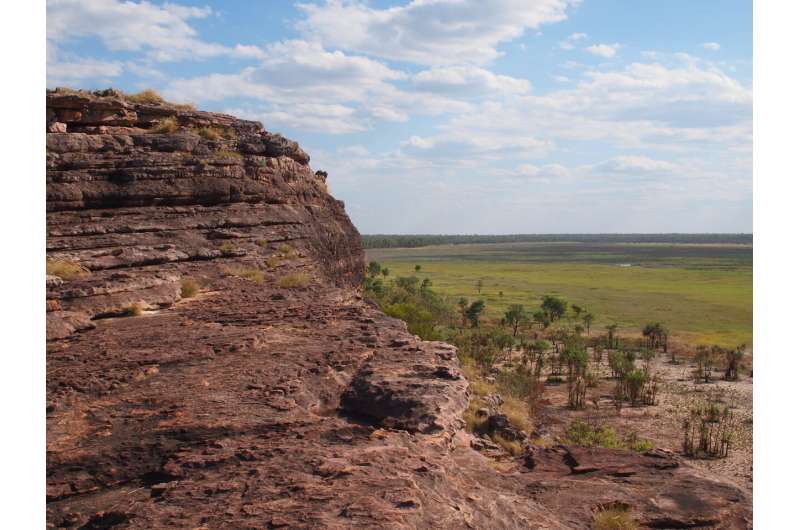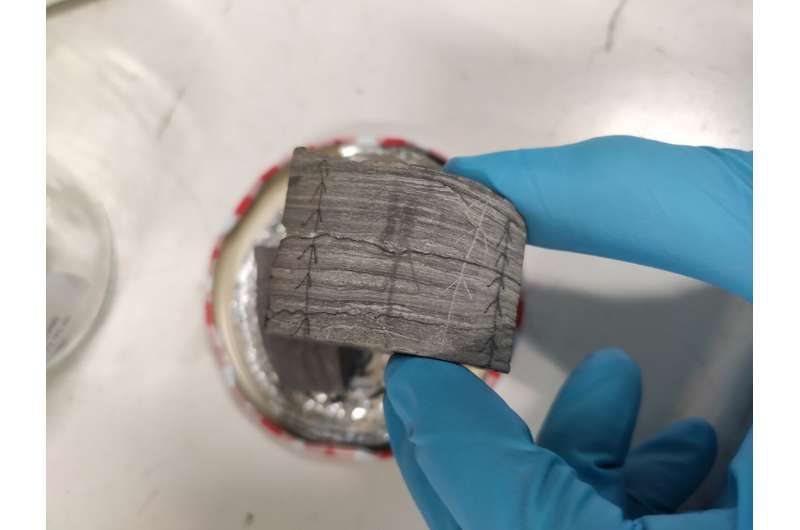This article has been reviewed according to Science X's editorial process and policies. Editors have highlighted the following attributes while ensuring the content's credibility:
fact-checked
peer-reviewed publication
trusted source
proofread
Genetic methods enable the use of fossil lipids as biomarkers for oxygen-producing primordial bacteria

Cyanobacteria are a key species in Earth's history, as they introduced atmospheric oxygen for the first time. The analysis of their evolution therefore provides important insights into the formation of modern aerobic ecosystems. For a long time, a certain type of fossil lipid, so-called 2-methylhopanes, was considered to be an important biomarker for Cyanobacteria in sediments, some of which are hundreds of millions of years old.
However, this came into doubt when it turned out that not only Cyanobacteria but also Alphaproteobacteria are genetically capable of producing these lipids.
An international research team led by Yosuke Hoshino from the GFZ German Research Centre for Geosciences and Benjamin Nettersheim from MARUM—Center for Marine Environmental Sciences at the University of Bremen has now studied the phylogenetic diversification and distribution of the genes—including HpnP—that are responsible for the synthesis of the parent lipids for 2-methylhopanes: The researchers have deciphered when these genes were acquired by certain groups of organisms.
They were able to show that HpnP was probably already present in the last common ancestor of Cyanobacteria more than two billion years ago, while the gene only appeared in Alphaproteobacteria about 750 million years ago. For the times before that, 2-methylhopanes can therefore serve as a clear biomarker for oxygen-producing Cyanobacteria.
The study, published in the journal Nature Ecology & Evolution, shows how genetics, in interaction with sedimentology, paleobiology and geochemistry, can improve the diagnostic value of biomarkers and refine the reconstruction of early ecosystems.
The importance of cyanobacteria in Earth's history
Cyanobacteria played a crucial role in transforming the Earth from its initial oxygen-free state to a modern, oxygen-rich system in which increasingly complex life is possible.
Cyanobacteria were probably the only relevant group of organisms that converted inorganic substances into organic ones (so-called primary producers) and produced oxygen for long stretches of the Precambrian (the first four billion or so years of Earth's history, from its beginnings to about 540 million years ago).
Therefore, the analysis of their evolution is of great importance for understanding the common history of life and Earth.
The importance of fossil lipids as biomarkers
In principle, the fossil remains of whole Cyanobacteria can serve as an indicator of the presence of oxygenic photosynthesis in the geological past. However, due to preservational biases and ambiguities in recognizing fossil cyanobacterial cells, geochemists rather use fossilized diagnostic lipids, such as 2-methylhopanes. 2-Methylhopanoids (non-fossilized parent molecules) are produced by the bacteria and—in contrast to the bacteria themselves—can be fossilized and detected in sedimentary rocks even after hundreds of millions of years in good quality and in quantities corresponding to their original occurrence.
However, there have recently been doubts about the suitability of 2-methylhopane as a biomarker for Cyanobacteria: the discovery of the lipid biosynthesis gene revealed that Alphaproteobacteria are also capable of producing these lipids. This means that temporally tracing oxygen-producing processes on Earth by 2-methylhopanes is no longer possible.
New approach: Comprehensive genetic analysis combined with new, high-purity sediment analyses
An international research team led by Yosuke Hoshino and Christian Hallmann, scientists in GFZ Section 3.2 "Organic Geochemistry", and Benjamin Nettersheim from MARUM at the University of Bremen has now systematically investigated which organisms other than Cyanobacteria possess the genes (abbreviated as the SC and HpnP genes) necessary for the production of 2-methylhopanoids, and when they acquired those genes during the course of evolution.
In this way, the team was able to show that the fossil lipid 2-methylhopane can still be used as a clear biomarker for the existence of Cyanobacteria for times dating back more than 750 million years.

In addition, the researchers have created an integrated record of 2-methylhopane production over the course of Earth's history. For this, they combined their molecular data with new sediment analyses carried out under high-purity conditions.
"The method we proposed is in principle applicable to any organic matter in geological archives and has great potential to trace the evolution of different ecosystems with much higher temporal and spatial resolution than before," Hoshino sums up.
Methodology I: Computational study for genetic analysis
For the analysis of the genetic relationships, Hoshino searched publicly available databases, containing millions of gene and protein sequences, for organisms with the SC and HpnP genes.
Based on this genetic data set, he created so-called phylogenetic trees, which provide information on how the SC and HpnP genes were transferred between different organisms and whether the gene transfer took place vertically via inheritance or horizontally between evolutionarily unrelated organisms.
Furthermore, the researchers were also able to determine when individual gene transfers took place in the evolutionary history of the genes by comparing previous studies that utilized the so-called molecular clock technique that takes into account the DNA mutation rate and estimates the timeline for the gene evolution.
Methodology II: New type of ultra-clean sample preparation
In addition, because Precambrian biomarker records are extremely sensitive to contamination, the researchers used an ultra-clean method to extract organic matter from sediment cores. The geological samples in the form of cores were collected by several co-authors from 16 countries. They represent different geological periods from the Paleoproterozoic (2.5 billion years ago) to the present. The relative abundance of 2-methylhopanes was then measured in the organic matter.
The results in detail
There are many bacteria that possess both SC and HpnP genes, but they are mainly Cyanobacteria and Alphaproteobacteria. Each group is found to have acquired the two genes independently.
This is in contrast to earlier studies that concluded that Cyanobacteria acquired these genes from Alphaproteobacteria at a late stage in their evolution. The new study further revealed that the common ancestor of Cyanobacteria already possessed both genes more than 2.4 billion years ago, when oxygen began to accumulate in the atmosphere during the so-called Great Oxidation Event.
In contrast, Alphaproteobacteria acquired the SC and HpnP genes at the earliest only 750 million years ago. Before that, 2-methylhopanoids were thus only produced by Cyanobacteria. The researchers interpret a slightly delayed increase of sedimentary 2-methylhopanes around 600 million years ago as a sign of the global spread of Alphaproteobacteria, which may have favored the concurrent evolutionary rise of eukaryotic algae.
Summary and outlook
"The individual analytical methods mentioned above are not new, but few researchers have attempted to perform comprehensive analyses for SC and HpnP and to integrate genetic data with sedimentary biomarker data before, as this requires combining two completely different scientific disciplines—molecular biology and organic geochemistry," says Hoshino.
"The source of sedimentary 2-methylhopanes has been a topic of long debate," adds Christian Hallmann. "This new study not only provides clarity about the diagnosticity of 2-methylhopanes and the role of Cyanobacteria in deep time; its methodology offers a new avenue forward to refine the diagnosticity of, in theory, any biomarker lipid once the biosynthesis genes are known".
More information: Yosuke Hoshino et al, Genetics re-establish the utility of 2-methylhopanes as cyanobacterial biomarkers before 750 million years ago, Nature Ecology & Evolution (2023). DOI: 10.1038/s41559-023-02223-5
Journal information: Nature Ecology & Evolution
Provided by Helmholtz Association of German Research Centres




















